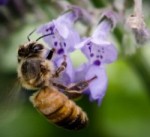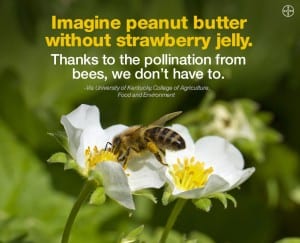
Cathy Isom tells us about the national campaign creating quite a buzz for honey bees. You may recall Bayer CropScience launched the Feed a Bee campaign last year. A major new initiative to increase forage for honey bees and other pollinators.
Feed a Bee
From Bayer CropScience Feed a Bee website
 Honey bees play an important role in pollinating many of our fruits, nuts and vegetables, which help contribute to a healthy, nutritious diet. Since bees are so important to our agriculture, we all need to do our part to help them thrive.
Honey bees play an important role in pollinating many of our fruits, nuts and vegetables, which help contribute to a healthy, nutritious diet. Since bees are so important to our agriculture, we all need to do our part to help them thrive.
Lack of diverse food sources is a major obstacle to improving honey bee health. Quite simply, bees do not have access to all the pollen and nectar sources that they need.
The Feed a Bee initiative will create forage areas with a diversity of bee-attractant plants for honey bees. To accomplish this goal, Feed a Bee will educate consumers about pollinator food shortage and work with them to plant 50 million flowers to increase bee forage areas. Feed a Bee will also tap into the power of collaborations  by working with 50 organizations to plant thousands of acres of cover crops for bees.
by working with 50 organizations to plant thousands of acres of cover crops for bees.
The Feed a Bee campaign is supported by the Bayer Bee Health program’s honey bee research. Feed a Bee collaborations will use this research to guide plantings of the best bee-attractant habitats. The research will also be used to provide consumer tips on planting bee forage.
A good resource is the Pollinator Partnership’s Bee Smart app, which will guide you in selecting plants for pollinators specific to your area. This is downloadable for the iphone or android devices. Visit www.pollinator.org/guides.htm.
For more information on bee health, please visit beehealth.bayer.us.









